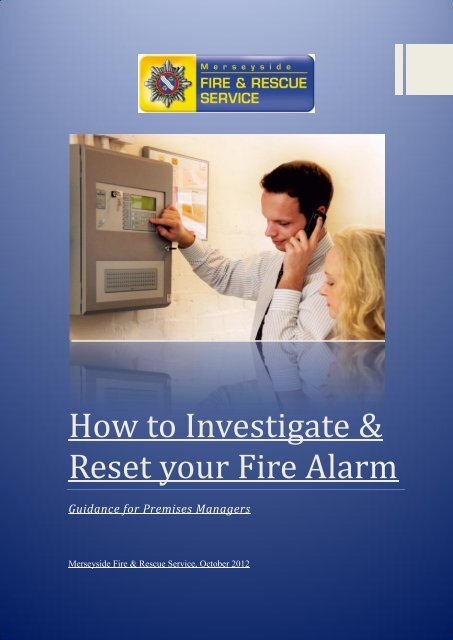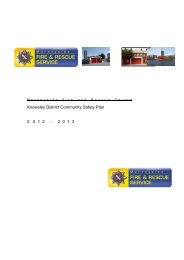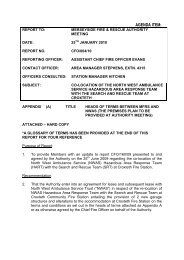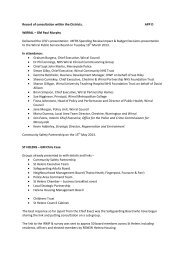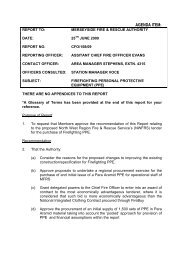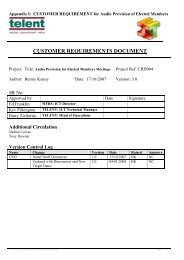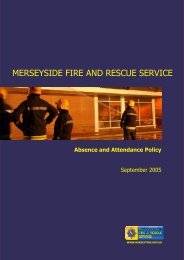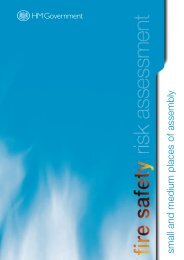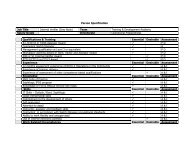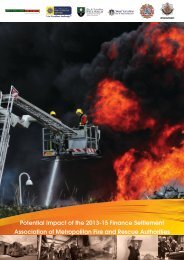How to Investigate & Reset your Fire Alarm - Merseyside Fire and ...
How to Investigate & Reset your Fire Alarm - Merseyside Fire and ...
How to Investigate & Reset your Fire Alarm - Merseyside Fire and ...
- No tags were found...
Create successful ePaper yourself
Turn your PDF publications into a flip-book with our unique Google optimized e-Paper software.
<strong>How</strong> <strong>to</strong> <strong>Investigate</strong> &<strong>Reset</strong> <strong>your</strong> <strong>Fire</strong> <strong>Alarm</strong>Guidance for Premises Managers<strong>Merseyside</strong> <strong>Fire</strong> & Rescue Service, Oc<strong>to</strong>ber 2012
<strong>Fire</strong> or False <strong>Alarm</strong>?There's a price <strong>to</strong> pay for false alarms. In some businesses the disruption they causehas cost as much as £120,000 a year. Worse, they can cost lives, because firefighterscan't be in two places at once.We will no longer send fire appliances <strong>to</strong> calls from buildings where the onlyinformation available is that a 'fire alarm is sounding'. Correct application of theadvice below will ensure that, in the event of a real fire, the full attendance is sentimmediately.To prevent the disruption <strong>and</strong> the risk posed by false alarms, <strong>and</strong> ensure theappropriate attendance is sent, we're asking building managers <strong>to</strong> investigate thesource of fire alarm actuations before fire crews turn out, provided this process canbe undertaken safely.Whether it's a fire or false alarm, always ensure the building is evacuated inaccordance with <strong>your</strong> emergency procedure whenever the alarm activates.When staff investigate, they should leave the building by the nearest fire exit <strong>and</strong>summon the fire service using the 999 system if at any time they so much as thinkthey've seen signs of a fire. We're not asking them <strong>to</strong> be absolutely certain; it'll be ourjob <strong>to</strong> check reports of fire or physical signs of fire.<strong>How</strong> <strong>to</strong> investigateRemember you're looking for signs of a fire <strong>and</strong> not a fire itself. If there's an obviousfire there's no need <strong>to</strong> investigate simply phone 999 telling us what has happened<strong>and</strong> we'll be on our way.oooooooWhere possible, don't search for signs alone. Consider searching in pairs.Check the fire alarm panel <strong>to</strong> find where the alarm has activated – it's vitalthat you have a full zone or detec<strong>to</strong>r plan displayed immediately adjacent<strong>to</strong> the panel.Have another member of staff at the alarm panel <strong>and</strong> remain in contact(mobile phone or short range radios are ideal for this purpose).When investigating look, listen <strong>and</strong> smell for signs of fire. It might besmoke, unusual noises or heat <strong>and</strong> could be any one, some, or all ofthose signs.Before opening a door feel it with the back of <strong>your</strong> h<strong>and</strong>, as high up thedoor as you can reach, for signs of heat. If it is hot do not open the doorIf at any time you discover signs of fire, raise the alarm, get out using thenearest fire exit <strong>and</strong> call the fire service on 999.When the call <strong>to</strong> the fire service is made, clearly state that an investigationhas taken place <strong>and</strong> this is a call <strong>to</strong> a FIRE <strong>and</strong> not just an alarmsounding.1 | P a g e
No signs of fire?<strong>Reset</strong> procedures following a False <strong>Alarm</strong>The following advice will help you <strong>to</strong> comply with fire safety legislation, keep <strong>your</strong>staff <strong>and</strong> premises safe <strong>and</strong> avoid future fire alarms:oooooIt is good practice <strong>to</strong> allow the evacuation <strong>to</strong> complete (interrupting anevacuation is confusing <strong>and</strong> leads <strong>to</strong> a false sense of security that everyalarm is false)Ensure that whoever has been given the responsibility <strong>to</strong> reset the firealarm are trained <strong>and</strong> competent <strong>to</strong> do so. If arrangements have beenmade with a third party <strong>to</strong> ensure the alarm is reset, (such as an on callfire alarm company) details of how <strong>to</strong> contact the company should bedisplayed immediately adjacent <strong>to</strong> the panelAny third party company contracted <strong>to</strong> reset <strong>your</strong> alarm should be able <strong>to</strong>attend within a reasonable time period as most fire alarms will not detectanother fire if they are in 'silenced' mode or have not been fully reset<strong>Fire</strong>-fighters will not reset <strong>your</strong> fire alarm system for you. It is <strong>your</strong>responsibility <strong>to</strong> reset, or employ an on-call alarm company <strong>to</strong> reset foryouEnsure the details of any false alarm are recorded in the fire alarmlogbook. Record why it happened (if known) <strong>and</strong> its specific location. Thisis essential <strong>to</strong> demonstrate <strong>your</strong> compliance with fire safety law <strong>and</strong> <strong>to</strong>ensure the correct information is available <strong>to</strong> ensure it doesn't happenagaino All false alarms should be reported <strong>to</strong> the premises manager so thatappropriate action can be taken <strong>to</strong> avoid further false alarmsCauses <strong>and</strong> potential2 | P a g e
Causes <strong>and</strong> potential solutions <strong>to</strong> avoid false alarmMany false alarms result from activities carried out near <strong>to</strong> fire detec<strong>to</strong>rs, particularlysmoke detec<strong>to</strong>rs. To prevent unwanted false alarms, you should consider thefollowing common causes <strong>and</strong> solutions <strong>and</strong> do something <strong>to</strong> s<strong>to</strong>p them fromhappening in <strong>your</strong> workplace.CauseCooking fumesSteam(i.e. from showerrooms)Steam(from industrialprocesses)Smoking (cigarettes)Aerosol spraysHot work/dustyworkAccidental damage<strong>to</strong> a 'Break Glass'call pointTesting ormaintenanceChanges <strong>to</strong> theuse, or practiceswithin the buildingSolutionEnsure cooking is only allowed in designated locations whichhave appropriate detection (usually heat). Correct use ofextrac<strong>to</strong>r fans <strong>and</strong> the closing of doors between designatedcooking areas <strong>and</strong> detec<strong>to</strong>r heads can further prevent falsealarms.Ensure there is adequate ventilation in the shower room <strong>and</strong>keeping doors <strong>to</strong> outer rooms closed. Sometimes signage canhelp guests / staff; underst<strong>and</strong> the need <strong>to</strong> close doors <strong>and</strong>take action <strong>to</strong> avoid build-up of excessive steam.Ensure an appropriate detec<strong>to</strong>r type is fitted; seek advice froma qualified alarm engineer.Should only be allowed in designated locations protected byappropriate detec<strong>to</strong>rs i.e. designed <strong>to</strong> be suitable for the riskwhilst not being susceptible <strong>to</strong> actuation from cigarette smoke.Where possible, you should prevent the use of aerosols in thevicinity of fire alarm detec<strong>to</strong>r heads, where such cannot beavoided use of alternative products should be considered.Consider fitting temporary covers on detec<strong>to</strong>rs while theactivity is being carried out. Temporary covers should only befitted by approved staff <strong>and</strong> removed immediately after theactivity has ended. Whilst detec<strong>to</strong>rs are covered in this way,staff working in the area (including contrac<strong>to</strong>rs) should bebriefed <strong>to</strong> activate a 'break glass' call point if they see a fire.Consider protecting susceptible break glass call points withapproved covers or guards.Prior <strong>to</strong> commencing any testing or maintenance you mustinform <strong>your</strong> alarm centre <strong>to</strong> take <strong>your</strong> system 'off watch' for theduration of the activity.Ensure the fire-detection system is appropriate for how thebuilding is used.Some of the solutions above are management related <strong>and</strong> can be resolved bymanagement actions alone. Others rely on changes <strong>to</strong> the fire alarm system.Changes <strong>to</strong> fire alarm systems should only be undertaken by a competent person orcontrac<strong>to</strong>r. Any such changes should only be undertaken after a fire risk assessmenthas been carried out <strong>and</strong> should be documented on appropriate certification kept in<strong>your</strong> fire safety logbook.3 | P a g e


